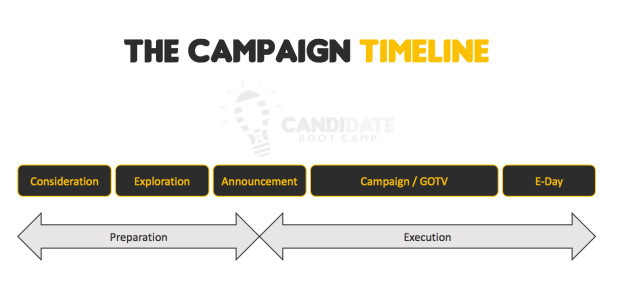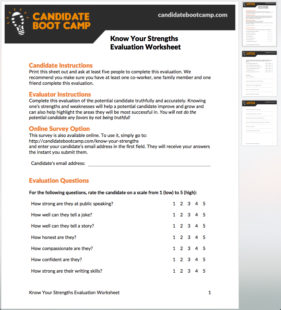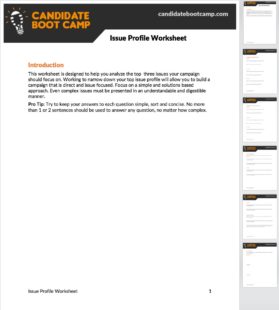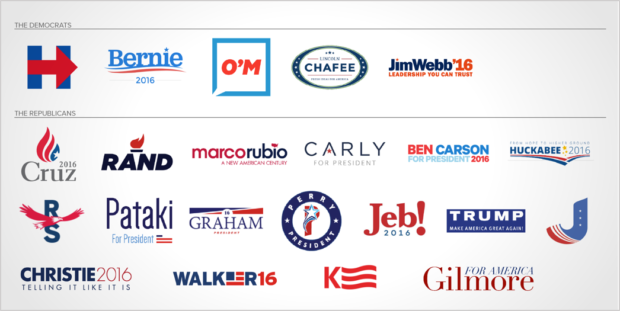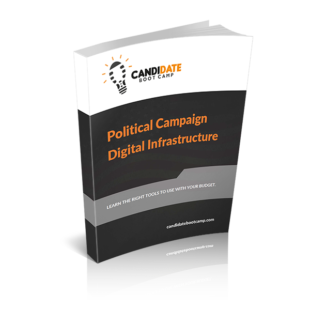How to Run for Political Office in 2022
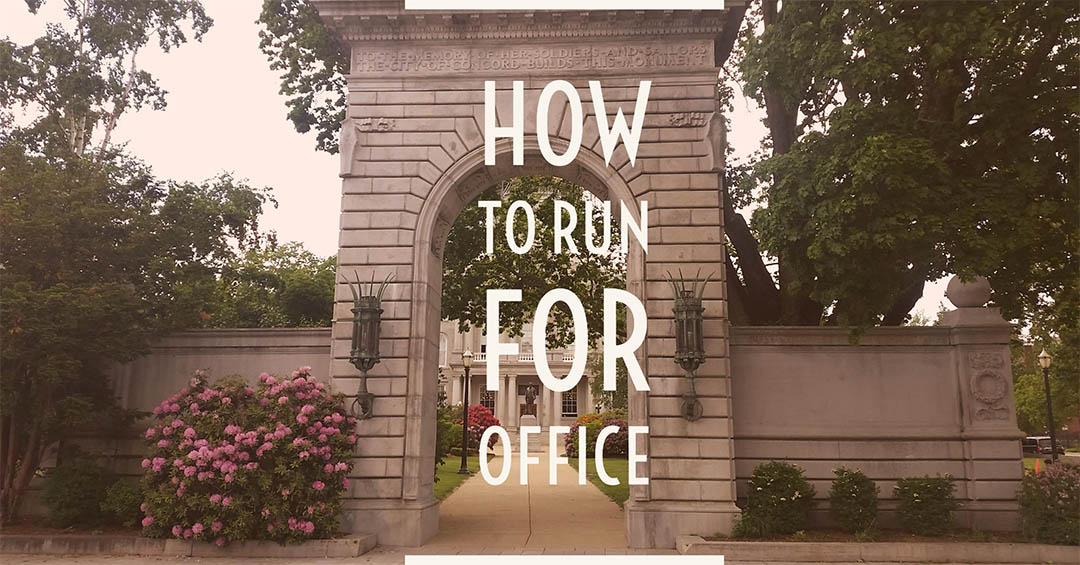
Here are the basic steps we’ll cover:
- Considering a Run for Office?
- Political Campaign Structure and Organization
- Exploratory Phase
- Pre-announcement Steps
- Announcement Day
- Campaign Strategy, Priorities, and Tactics
- Gowing Support
- The Day After Election
Throughout this discussion, we’ll refer to our campaign timeline (click for full-sized image):
You’ll notice that we’ve broken the timeline into two distinct phases: preparation and execution. We can’t stress enough how important the preparation phase is for a campaign. You will save yourself a lot of time and money if you invest in this phase before announcing your candidacy! Almost half of the steps we’ll discuss occur before the execution phase.
1 – Considering a Run for Office?
 The very first question you need to answer is, “Am I ready to run?” Running for political office is a major commitment and you’ll want to think it through, first.
The very first question you need to answer is, “Am I ready to run?” Running for political office is a major commitment and you’ll want to think it through, first.
The first step is to understand the office. What is the name of the office you’re running for? What are the specific traits and qualifications that this office-holder must have in order to do a good job? Why are you qualified? Write down at least three specific reasons why you are. Be sure you understand whether or not the office is partisan (Republican, Democrat, etc.) or non-partisan. How long is the term and what is the time commitment required? Are there requirements to hold the office like age, residency, etc.? What are the dates of the primary and general elections? And, finally, what do you need in order to win? Is it a plurality or a majority? Is there a run-off?
The second step is to evaluate your core network. Have you discussed a potential campaign with your spouse or partner? How about your closest friends? These will be your earliest supporters, so it’s important to know if they’re on board. What about your career? Will the campaign conflict with your employment or in any way conflict with other responsibilities?
Next, you will want to understand the time commitment required for the office. Will it require a leave of absence from your job? Will it be manageable with your current work/life balance or will that require some adjustment? How many hours per week will you be able to set aside for campaigning? Later, we’ll show you how to put together a campaign calendar to estimate this. Sometimes, speaking with someone who currently holds or recently held this position can describe the time commitment to you.
Finally, take a look at your finances. Are you current with your local, state, and federal taxes? Do you have outstanding parking tickets or other debts owed to local, state, or federal government? And are you willing to spend some of your personal finances on the political campaign? If so, how much? You may have no idea how much you’ll need to run a campaign. A good place to start is to look up campaign finance disclosures from past races. These are public documents you should be able to find on your town, city, county, or state website. Understanding how much other candidates have raised and spent in the past (especially successful ones) will give you a ballpark estimate. If you’re not going to fund the campaign yourself, are you willing to ask friends, family, and strangers to donate? This isn’t the easiest thing to do but we’ll provide some advice.
Additional Resources
2 – Political Campaign Structure and Organization
 Campaign Organization
Campaign Organization
What are the roles in a political campaign?
- Candidate
- Campaign manager
- Fundraising director
- Communications director
- Networking director
- Events director
Depending on the size and scope of your campaign, you might fill several (or all) of these roles on a daily basis. Larger campaigns might have the capacity to fill some or all of these roles with volunteers and/or paid professionals.
So how do you build out a support network to help contribute to all of these campaign roles? Here are a few suggestions:
- Friends and family are always a great place to start!
- Put together a steering committee of friends, family, and supporters who can provide advice and network on your behalf.
- A finance committee is also a great asset. Obviously, having someone who has experience with raising and/or managing money involved or running this committee is a bonus.
- Building a rapid response team is extremely useful in our 24/7, social media environment. If you have a small team of folks who know your campaign messaging, they can tag-team responses to news story comments, social media trolls, constituent complaints, etc.
- The most important advice we can give you is never to turn away a volunteer! Find out what their strengths are and use them but don’t try to fit a square peg into a round hole. For example, if you know someone who is an introvert but wants to help, they probably won’t feel comfortable knocking on doors or making phone calls. Instead, find out if there are other tasks he or she can do that are better aligned with their skills and personality.
Budgeting
How much do you need to budget for your run for office? That’s hard to know, especially if you’re running for the first time. One good way to get a ballpark estimate is to look up campaign disclosures for previous campaigns. How much have other candidates raised and spent in the past? If this is your first run, you might have first-time expenses you wouldn’t necessarily need in subsequent elections, like your website or yard signs (if you have enough left over).
So, what should you spend it on? The short answer is, “Stuff that will help you earn more votes.” Hats and t-shirts, for example, may seem like a fun way to gain some exposure but they’re not nearly as effective as other methods. Likewise, expensive events can drain a lot of time and money from your campaign for relatively little benefit. Conversely, investing in traditional lawn signs and targeted direct mail are very cost effective, traditional ways to earn name recognition and exposure. Think about it this way: A $1 lawn sign on a busy street can easily be seen by thousands of people every day. How many people will see a $20 t-shirt? You can learn more about direct mail and smart budgeting from our interview with BJ Perry of Talient Action Group:
What to Include In Your Campaign Budget
Here’s an outline of items that would be contained in a complete campaign budget. Keep in mind that your campaign probably won’t include or require everything on this list.
- Operations
- Salaries
- Voter files and databases
- Website
- Gas
- Office space (include internet, rent, heating, etc.)
- Fees (bank, payment processing)
- Office supplies
- Voter Contact
- Direct mail
- Radio ads
- Radio production
- Digital advertising
- Live & automated calls
- Palm cards
- Business cards
- Yard signs
- U-posts, poles, and zip ties for road signs
- Banner
- Newspaper ads
- Volunteer expenses
- Canvasing (door to door)
- Community meetings
- Get out the vote (GOTV) operation
- Fundraising
- Fundraising events
- Printing
- Postage
- Letterhead and envelopes
- Donation cards
You can download a campaign budget template (MS-Excel file) by clicking on the image below:
Communications
 We think it’s useful to think of communications in terms external and internal. External communications mean delivering your message to the outside world, while internal communication means keeping your message straight and consistent within your team.
We think it’s useful to think of communications in terms external and internal. External communications mean delivering your message to the outside world, while internal communication means keeping your message straight and consistent within your team.
External Communications
Paid media is the first external communication channel to consider. There are lots of options available here; newspaper, print, digital, radio, television, etc. Be very careful when considering paid media and mindful of the cost per thousand impressions, or CPM. That’s a measure of how many dollars it takes to reach 1,000 people. Those costs can vary widely between medium and some of them have ways to get free coverage.
Free media coverage is typically referred to as “earned media.” This frequently comes in the form of news stories in television, radio, and/or newspapers. But there are other ways to acquire earned media. In television, there may be community access cable shows that you can tap. Similarly, reach out to local talk radio stations to see if they will do interviews with candidates. And letters to the editor in newspapers are a great way to get your message out to voters.
Social media is a must for any political candidate. We recommend that you create a Facebook page, first and foremost. Pages are different from your personal profile in that they are public and have no limits on how many people can “like” your page. You’ll also need one if you want to do paid Facebook advertising. In addition, you should make sure your LinkedIn profile is up to date and optimized.
Internal Communications
We may be repeating ourselves, but this is important: If people are going to volunteer their time to your campaign, it’s critical that you value and respect their time. One way to do that is to keep them in the loop and stay on top of activities. The last thing a volunteer wants to learn is that they’ve wasted their time because of duplicated effort, misplaced priorities, etc. So make sure you’re in regular communication with your team and the left hand knows what the right hand is doing.
Staying on message is also important! We’ll talk more about branding and messaging later in this article. But once you do understand what your campaign message is, everyone needs to know what it is. Ideally, you’ll want to have a communications director who can vet any work done by the team before it goes public.
Building a Database
The ability to send emails to supporters, donors, and voters is crucial! You don’t want to use your personal email for many, many reasons. You’ll want a professional, third-party email provider for this. There are two solutions we recommend.
The first is ActiveCampaign. There’s no free version, so you ‘ll have to spring for a minimum of $9 per month. The price goes up as you add more contacts to your database. The reason this is our first choice is that in addition to sending emails to your contacts, it can also serve as your campaign database. Most candidates will use spreadsheets for this, but this far from ideal. It’s too easy to corrupt the data and it’s not particularly easy to do anything with the information. If you utilize ActiveCampaign instead, in addition to sending your contacts email you can also track all of your calls, any donations they’ve made, events, they’ve attended, etc. This is all powerful information and it’s not very expensive.
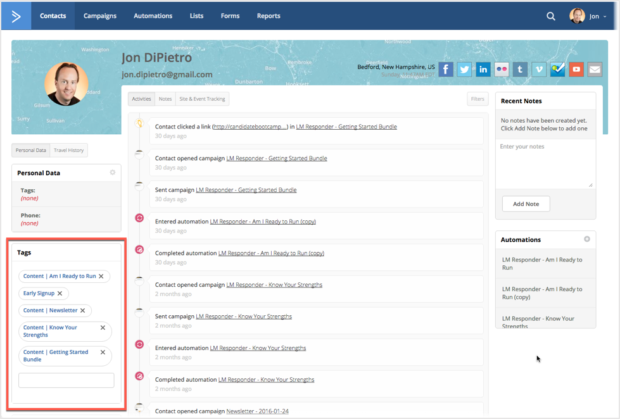
If you can’t afford ActiveCampaign, then our second choice is Mailchimp. They have a free version that allows you to send up to 12,000 emails per month to a list of up to 2,000 subscribers. That’s going to be plenty for most campaigns but you’ll sacrifice the ability to use it as a campaign database. Even the paid version won’t support that type of functionality.
Regardless of whether you use one of those solutions or just a spreadsheet, the list is only as good as the care you put into it. The more detail you can collect about each contact in your database, the more valuable it will be. Keep track of who is a volunteer, has donated, displays a yard sign, attended an event, etc. This will allow you to send more targeted messages to your contacts.
Additional Resources
3 – Exploratory Phase
Filing for Office
 Be sure to understand exactly what the requirements are to file for your seat. You can usually find this out by checking with your town clerk or Secretary of State. Make sure that you meet the requirements for the office. Make a list of any and all paperwork required to file along with the deadlines. Find out if you need to collect signatures and/or pay a filing fee.
Be sure to understand exactly what the requirements are to file for your seat. You can usually find this out by checking with your town clerk or Secretary of State. Make sure that you meet the requirements for the office. Make a list of any and all paperwork required to file along with the deadlines. Find out if you need to collect signatures and/or pay a filing fee.
Finance Laws
Reporting requirements for political offices vary widely from town to town and state to state. The Campaign Finance Institute has a handy set of links for you to research the laws in your district. Find out when reports are due, what donation limits are, what information you need to collect, and the time frames in which you can accept donations.
Issue Profile
I remember watching a local community access television show two days before a recent primary election. They brought in six candidates for state office and asked them all the same questions. One of those questions was, “Why are you running for office?” Stunningly, two of them replied by saying, “That’s a good question.” These candidates hadn’t even answered the most fundamental question and it was 48 hours before the election!
It’s a good idea to analyze the top-three issues your campaign is going to focus on. Make a list of the most important issues you can impact as an elected official. For each issue, answer the following questions:
- What are some of the prevailing solutions and/or plans for this issue?
- What are some of your solutions and/or plans for this issue?
Next, take stock of your own personal and professional background. What are three areas in which you have unique skill sets or specialized experience? How do these skills/experience assist your ability to solve or add value to the three issues most important to you? How do these skills/experience assist your ability to solve or add value to the three issues most important to the public?
Narrow these lists down to the top 2 or 3. Of the remaining issues, which do you also have the greatest skills/experience to bring about a solution? If your skill sets do not connect strongly with any of the reaming issues, which issue remaining is most important to the public? Finally, in 1 or 2 sentences, explain your opinion, thoughts, and opinion for each issue.
Know Your Strengths
 Some people are their own worst critic. Others, shall we say, have a slightly more flattering view of one or more personality traits than other might think. Either way, understanding your true strengths and weaknesses can be a tremendous advantage!
Some people are their own worst critic. Others, shall we say, have a slightly more flattering view of one or more personality traits than other might think. Either way, understanding your true strengths and weaknesses can be a tremendous advantage!
Here are some of the areas to think about and rate yourself on a scale of 1 to 5:
- How strong are you at public speaking?
- How well can you tell a joke?
- How well can you tell a story?
- How honest are you?
- How compassionate are you?
- How confident are you?
- How strong are your writing skills?
- How easy-going and flexible are you?
- What kind of leadership skills do you have?
- What is your overall temperament?
- How are your organizational skills?
- Are you approachable?
- Are you involved in the community?
In addition to those ratings, answer the following questions:
- What is your best quality?
- What is your number one area in need of improvement?
- What would you consider your biggest pet peeve?
- Do you consider yourself to be generous?
- Describe yourself in three words.
- How do you describe your job?
- What charity or community area is most important to you?
- Do you have the necessary life experience?
- Would you vote for yourself?
It’s even more valuable to get this information from your friends, family, and colleagues. But they probably wouldn’t be 100% honest to your face so we’ve created an online tool you can use to collect this information anonymously. Ask them to go to our Know Your Strengths online survey (https://candidatebootcamp.com/know-your-strengths/) and be sure to have them enter YOUR EMAIL ADDRESS. This way, you’ll receive an automatic email with each set of answers and it’s completely anonymous.
Additional Resources
4 – Pre-Announcement Phase
Branding and Messaging
At the center of nearly every successful campaign is a consistent and identifiable brand and message. Political branding and massaging in many ways represents both the tangible and intangible “aura” of a campaign.
In 2008, then-Senator Barak Obama’s central campaign messaging was one of change to the status quo and hope for a renewed America. This central campaign message was effectively repeated and reinforced throughout his campaign in nearly every political platform from speeches to social media and online marketing. This message was then bolstered with a brand of youthfulness and a bold color of blue.
Presidential Barak Obama’s 2008 campaign for president is just one of countless examples of how effective branding and messaging can pay substantial dividends to victory on election day. Although you may not be seeking the office of U.S. president, establishing your political brand and messaging can be vital to your campaign success.
The branding of a candidate for local office can take on many different shapes and sizes. Perhaps your brand and messaging are of a successful small businessperson who is looking to bring your experience to your local Aldermanic Board. Another example could be that you are a hard-working community member that has a focus on constituent service. Whatever the case may be, identifying your brand and messaging can help keep your campaign better focused and manageable.
Political Brand
A good political brand has three key components:
- Authenticity – A strong brand needs to be one that is believable and natural to the candidate. The start of an election is not the time to become a profoundly different person.
- Relevance – Being closely in line with the matters at hand are vital t a successful brand image. Voters want to know that you not only understand what is important in the community, but also that you are relatable to themselves and their families.
- Differentiation – Part of your brand should reflect what you offer or what makes you and your candidacy a better value proposition for the voter.
Political Messaging
We define good political messaging as the art of conveying or highlighting successes, failures, differentiating factors or the need for change in a way that is beneficial to the candidate.
That may seem like a lot, but when we break it down it is a little more manageable.
In order to understand what your successful political messaging may be, one good underling principal to understand is that not everyone is as interested and involved in politics or local matters as you are. Just by being interested in running for elected office, you have already placed yourself above a great number of your peers when it comes to interest in political matters.
Additionally, it is important to note that many people do not even vote. Just about 60% of the eligible voting population votes during presidential election years, and about 40% vote during midterm elections. Turnout is often even much lower during local elections.
What does this all mean? It means that when you craft your messaging it is important to keep it simple, clean, and concise. You should be able to convey your core message without having to present a policy briefing or assuming that the voter has a deep background on the topic. The painstaking details of your solutions should not be contained in the context of your messaging. That doesn’t mean you shouldn’t be able to speak to the details, but those are more complex conversations that are outside of numerous four to five-minute voter interactions on the campaign trial.
Where do you start? We recommend that you take the top issues you narrowed down previously with the issue profile worksheet and use those as the foundation of your message. Ask yourself what the undying concept is that unites these policies or issues. Is the underlying concept one of taxes, infrastructure, overall change, better transparency, greater teamwork or the continuation of positive policies already in place? Whatever the overarching concept might be, make sure that your message is clear, simple and easily understood by the general voting public.
Putting It Together
The last key to making sure your branding, messaging and designing all work in conjunction is by consistent reinforcement. For your brand and message to “stick” to the voting public, you must make sure you are repeating and reinforcing the same items throughout the entire campaign. This means making sure that all your campaign materials, ranging from palm cards to yard signs to your website and social media presence, all have a similar feel, look, color scheme, design properties, and content.
The key points on your palm card should be consistent with what someone sees when looking at your website or hearing you speak at a community event. In the same way, the main color scheme on your yard signs should also be consistent on your website, social media and press releases.
To build a notable, effective and successful brand and message a heavy reliance on simplicity, consistency, and reinforcement are key to your success.
Planning Your Announcement
What are you going to say and where are you going to say it? Those are the two main things to think about regarding your political campaign announcement.
Think about answering the following questions in your announcement:
- What is your message?
- Why are you running?
- What do you want to accomplish with your announcement?
- What is the look/feel you’re going for?
- Should this be an event?
Finally, decide which medium makes the most sense for your announcement: Should this be a video on social media? A press conference? A local radio show interview? A newspaper opinion editorial?
Setting Goals
Setting goals for your campaign is critical. There are two areas in particular that will help you to constantly benchmark yourself and make sure you’re on target for victory.
Fundraising Goal
Hopefully, at this point, you’ve figured out how much you will need to spend on your campaign and created a budget. Now it’s time to set your fundraising goal and mapped out a path to achieve it. If your campaign is 5 months and you want to raise $5,000, is your goal to raise $1,000 per month or do you want to raise $2,500 in the first two months? There are no right or wrong answers here: It’s a matter of your own campaign plan and budget. Either way, it’s useful to create a plan and set goals so that you can track the performance of your campaign and make adjustments before it’s too late.
Vote Target
 Curiously, many candidates for local political office never bother to estimate how many votes they’ll need in order to secure a victory. We recommend looking up the results for the last three or four elections. Look at the total voter turnout and how many voters from each political party voted. It’s important to note the political environment of those elections. For example, turnout will be much heavier in Presidential election years.
Curiously, many candidates for local political office never bother to estimate how many votes they’ll need in order to secure a victory. We recommend looking up the results for the last three or four elections. Look at the total voter turnout and how many voters from each political party voted. It’s important to note the political environment of those elections. For example, turnout will be much heavier in Presidential election years.
Campaign Calendar
Creating a campaign calendar and timeline is an extremely useful tool. It’s not simply a calendar of events, though that’s certainly part of it. It should also include your goals and other tasks, milestones, and deadlines in your campaign. Where do you want to be in terms of fundraising? How many voters do you need to contact in order to reach your vote target? What local events can you attend? Mapping all of these tasks, milestones, and events ahead of time is a great way to organize your campaign and keep the entire team on the same page.
Campaign Infrastructure
The Internet has changed everything from the way we consume news to the way we buy stuff to the way we interact with one another. It has also changed the way we elect our political candidates. Presidential and Congressional campaigns are now hiring digital gurus and spending millions on data mining and advertising.
But here’s the thing: The Internet can be the Great Equalizer. If you understand the rules and know some of the tricks, you can get big results for small dollars. Some of the infrastructure components you’ll want to consider include:
Website – If you do nothing else with digital infrastructure, make sure you have a website as the home base for your campaign. It’s the single best digital tool available.
Accepting Donations – It’s hard work to convince people to donate to your campaign. Why would you make it even harder by not making it dead-simple for them to give you their money?
Social Media – Yes, social media is easy to do. No, social media is not easy to do well.
Contact Database – Smart campaigns keep a detailed list of supporters, volunteers, and constituents. Email is also a vital component of successful campaigns. We’ve already discussed a couple of tools you can use for this component.
Communication and Collaboration – In today’s connected world, word travels fast and the nimbler your campaign, the better equipped you are to deal with that. Using the latest messaging and collaboration technologies will help you do that.
Analytics – You can’t manage what you’re not measuring. If you go the trouble of building a website, engaging on social media, and paying for digital advertisements you need to be able to see what’s working and what isn’t.
Technology Stack
You have a lot of moving parts to manage in a political campaign. Like most things in business and everyday life, there are inventions for every necessity. In the Internet age, there’s no shortage of technologies available to help with any challenge. But the chances are you’re not an expert in any of those areas, let alone all of them!
Which technology is best? How to do you get them to work together?
Each campaign need has multiple solutions. That means there are dozens, maybe hundreds, of different combinations that can do the job. A “technology stack” is a collection of technologies that work together. In this section, we’ll share our recommended technology stack and explain the components.
Our technology stack presents a (more or less) complete digital solution for most small to medium campaigns. You don’t need to implement everything in this stack and you can substitute in most instances.
Let’s walk through these components one at a time. These are presented in relative order of importance.
Website
We’re going to sound like a broken record: Every candidate should have a website. It’s inexpensive and not terribly difficult to do yourself. Some of the benefits include:
- Visibility: Getting on the world wide web will give you much more visibility than just a Facebook page, for example.
- Ownership: You will own your website and all of its content. Forever.
- Functionality: As your campaign grows, your website can grow with it and support more and more features.
Donations
Your campaign will have a difficult time reaching voters without spending money for advertising, infrastructure, and in some cases staff. You’ll need donations to fund those activities and if it isn’t extremely simple, easy, and safe to give you money, you’ll be losing valuable donations.
Using a third-party solution removed several headaches you’d otherwise be forced to deal with.
- Credit Card Processing: Many donations are impulse decisions and you need to make the transaction quickly before the urge disappears.
- Online: These online services allow supporters to donate on their website and/or easily embed donation forms on your own website.
- Reporting: Depending upon your campaign size, you may be required to file reports with your state and/or the FEC. These services quickly and easily generate those reports for you.
Contact Database
See the earlier discussion about creating and using a contact database.
Social Media
I think by now all candidates understand the power of social media for their campaigns. But which channels should you use? And how should you use them? We’ll talk in more detail about this in a future chapter. However, we do want to mention another tool in our stack that we think can help organize your social media presence.
Some of the challenges with social media include:
- You’re likely active on more than one platform, so how do you share the same content efficiently?
- The times when you are online and posting content may not be the best times in terms of your audience presence. How do you address that?
- If you have a campaign calendar, how to you ensure that notifications and reminders go out at precisely the right times?
Analytics
Once you have a website running and are working on social media, it’s important to understand how much traffic your website is seeing and where it’s coming from. Google Analytics (www.google.com/analytics) is a very powerful, free tool that will monitor this traffic and give you the insights you need to adjust your digital strategies accordingly. It’s very easy to integrate with your website and since it’s free, why not take advantage?
If you plan on using Facebook extensively, we also highly recommend installing the Facebook tracking pixel. It’s similar to Google Analytics but it provides a much richer demographic profile of your visitors. It’s also free (you need to have a Facebook Page for this to be available).
Advertising
The great thing about digital advertising is that it’s easy for the novice to use! The bad thing about digital advertising is that it’s easy for the novice to use! What does that mean? It means that while it’s very simple for anyone to boost a post on Facebook or create Google AdWords campaign, it’s difficult to get great results.
That’s one of the reasons why our technology stack prioritizes analytics over advertising. If you don’t have the resources to implement decent online analytics, you shouldn’t be wasting your money with digital advertising because you’ll be flying completely blind. You’ll have no idea what’s working and what isn’t.
Digital advertising is a pretty big topic itself. We’ve written a whole ebook that will teach you how the basics plus a few insider tips and tricks.
Elevator Pitch
 Arguably, nothing will serve you better in your run for office than a well-crafted, much-rehearsed elevator pitch. If you’re not familiar with the term, it refers to a hypothetical scenario in which you’re in an elevator with someone important and have 30 seconds to make an impression. This is something you’ll want to revisit throughout the campaign and consider revising when and if circumstances dictate that you should.
Arguably, nothing will serve you better in your run for office than a well-crafted, much-rehearsed elevator pitch. If you’re not familiar with the term, it refers to a hypothetical scenario in which you’re in an elevator with someone important and have 30 seconds to make an impression. This is something you’ll want to revisit throughout the campaign and consider revising when and if circumstances dictate that you should.
Here are a few things to include in your elevator speech:
- Your name
- The office you’re running for
- One key topic or issue and how you plan to address it
- Close with a compelling reason why someone should support you
Bonus points if you can come up with multiple versions of your elevator speech for voters, donors, volunteers, etc.
Stump Speech
Hopefully, you’ll be making lots of public appearances throughout your campaign. On those occasions, it’s quite handy to have a stump speech prepared, practiced, and ready to go. A stump speech should be 3 to 5 minutes long and include:
- A clear open
- Explain who you are
- Explain why you’re running
- Present your ideas
- Close with an “ask” (e.g. vote for me, donate, volunteer, etc.)
Announcement Strategy
Finally, you’ll need to figure out your announcement strategy. You’ve already planned what you’re going to say and where you’re going to say it. Now is the time to create an action list based on that. What is your announcement date? Who exactly will receive your announcement? This is the point at which you will want to create a press list. Make a note of all of the local reporters and influencers (newspaper, television, radio, bloggers) who may cover your story.
Additional Resources
5 – Announcement Day
Pre-announcement Checklist
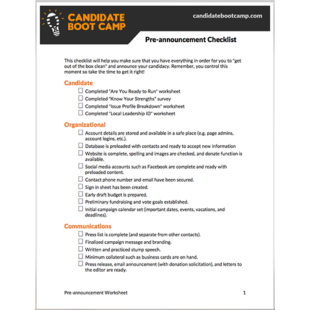 Before you press that launch button, here’s a checklist for you to double-check:
Before you press that launch button, here’s a checklist for you to double-check:
- Completed “Know Your Strengths” survey
- Understand rules and requirements for office
- Database is preloaded and ready for prime time
- Press list is complete
- Finalized campaign message and branding
- Written and practiced stump speech
- Infrastructure is up and running and tested
- Preliminary fundraising and vote goals established
- Campaign calendar
- Press release, email announcement, and letters to the editor
- Minimum collateral (business cards)
Announcement Day Opportunities
You only get one shot at your announcement day, so you’ll want to make the most of your opportunities. The first way to do that is to make sure you are playing offense. This is your first and best opportunity to define your candidacy. If you don’t do it, either reporters or your opponent will do it for you and that’s not a good place to be.
This is also a great opportunity to create content (photos, videos), generate earned media (news stories), motivate volunteers, and collect donations. Try to have a plan in place to leverage all of those opportunities.
Keep in mind that you have three audiences and it’s best if you can address all three as part of your announcement day strategy. First, the press is always looking for stories and content. The more you can give them, the better your chance will be for earned media. Second, unfamiliar supporters will hear your announcement message. Make it a good introduction by following the guidelines we’ve presented here for elevator and stump speeches. Finally, your supporters will be looking for validation. Be confident and consistent with the vision they’ve signed on to.
Announcement Day Objectives
What exactly are you trying to accomplish on announcement day? The first is to multiply your message. That is to say, generate as much buzz as you can by combining your announcement with letters to the editor, showcasing support from other community leaders, and by sending your announcement to your entire email list.
We mentioned that announcement day is a great opportunity to generate content like photos and videos. The good news about modern campaigns is that social media offers the ability to connect with voters in ways that never were possible before. The bad news is that it requires candidates to be more technically savvy than ever before.
Humans are visual creatures. Our brains are designed to remember faces and we respond accordingly. If your campaign can take advantage of this, it will give your social media presence a major advantage.
The more familiar you are with the following tools of the trade, the more and better content you can generate for your campaign:
- Smartphones
- Photography
- Videography
- Useful Apps
Finally, we’ll sum up this entire topic with a simple bit of advice: Make hay while the sun shines! The reality is that you’ll probably never get as much positive coverage as you will on announcement day so take advantage!
Rapid Response Team
 As soon as you announce, you should be prepared to respond to negative comments and/or attacks. Many of these will come via social media and comments on news articles. You can use Google to set up alerts that will automatically email you new online “hits” for your name. Create an alert for your name surrounded by square brackets (e.g. [jon dipietro]), as that will tell Google to match your name exactly. This will help alert you to new online articles or content about your campaign.
As soon as you announce, you should be prepared to respond to negative comments and/or attacks. Many of these will come via social media and comments on news articles. You can use Google to set up alerts that will automatically email you new online “hits” for your name. Create an alert for your name surrounded by square brackets (e.g. [jon dipietro]), as that will tell Google to match your name exactly. This will help alert you to new online articles or content about your campaign.
It’s also helpful to have a rapid response team of supporters willing to come to your aid and defense online. These volunteers should all be very well-versed in your messaging so that they can respond accurately, respectfully, consistently, and accurately.
Additional Resources
6 – Campaign Strategy, Priorities, and Tactics
Infrastructure Priorities
 Chances are that if you’re running a local campaign, you won’t have any paid staff. If your campaign budget is under $50k, then you’ll be relying on volunteers. But if your budget is between $50k and $100k, you should consider hiring at least one full-time staffer to manage your budget, your campaign calendar, coordinate events, etc. If your budget is over $100k then you can likely afford to hire multiple campaign staff positions who will work out of a physical campaign office.
Chances are that if you’re running a local campaign, you won’t have any paid staff. If your campaign budget is under $50k, then you’ll be relying on volunteers. But if your budget is between $50k and $100k, you should consider hiring at least one full-time staffer to manage your budget, your campaign calendar, coordinate events, etc. If your budget is over $100k then you can likely afford to hire multiple campaign staff positions who will work out of a physical campaign office.
Your budget will determine the extent of your other infrastructure spending, as well. We’ve already discussed your website and email communication as being priorities that will deliver some of the highest value.
But it’s equally important to know what NOT to prioritize. Be smart with your decisions by:
- Prioritizing fundraising
- Securing future investment
- Attracting new voters
Communications
How and what your campaign communicates to the press, supporters, and voters should be part of your overall campaign strategy. Your message should be well-defined by now. Why are you running? What is at stake? Why are you the best candidate for the job? Your elevator pitch and stump speech should be ready to go now.
So how do you use these as part of your campaign’s communications strategy?
Working With the Press
We talked about planning your announcement and making the most of the opportunity. Even if you did, that doesn’t mean that everyone heard your message or that the press even covered it. Press outreach should be an ongoing strategy throughout your campaign. If you followed our advice and prepared for announcement day, you should have a healthy amount of content you can repurpose. Photos, quotes, letters to the editor, and your stump speech are all components you can use in order to construct an “In Case You Missed It” message to reporters and supporters alike.
Paid Media
Another way to get your message in front of voters is through paid advertising. There are lots of channels available for this purpose. Unless you have a pretty large budget, television and radio advertising will probably be cost-prohibitive for your campaign. Some other affordable channels to consider include digital advertising and direct mail.
The first thing to know is that while there are lots and lots of different digital advertising networks available to you, we’re going to focus mostly on Facebook. There are two reasons for that. First, it is both the easiest and most flexible platform. Second, it is the most ubiquitous platform to reach your constituents.
If you’re a digital advertising professional, there are very good reasons to use other channels like Google AdWords, Display Network, and YouTube. But they require more work and knowledge up-front and on an ongoing basis than does Facebook. The bottom line is that if you’re going to pick just one digital advertising channel for your campaign, Facebook is almost always the best choice.

If you plan on spending any campaign funds on digital advertising, we recommend you read up on these 7 Facebook Advertising Mistakes Political Candidates Make.
For some great insights into using direct mail in your campaign, refer to the audio of our interview with BJ Perry of Talient Action Group earlier in this article.
Earned Media
 There are plenty of opportunities to generate coverage and publicity without paying for it. This is called earned media.
There are plenty of opportunities to generate coverage and publicity without paying for it. This is called earned media.
Newspapers have several means for generating earned media. Of course, you can be the subject of a story. Fostering relationships with reporters makes this easier and more likely, naturally. But you can also comment on stories in the online version of the local newspaper. Letters to the editor are another way to generate exposure for your campaign message. Finally, appearing at public events is another way to rub elbows with reporters and provide quotes that appear in stories.
Chances are good that there are local access cable television channels in your city or town, with shows who are always looking for content and guests. Similarly, local radio shows offer opportunities to appear for interviews.
Of course, social media is another channel that can be leveraged to generate earned media. The more you can post interesting (controversial?) content, the greater your chances will be. You can also read about 14 Social Media Mistakes to Avoid In Your Political Campaign.
Fundraising
We’ve written a lot about political fundraising on our blog. So rather than including all of that content in an already lengthy article, we’ll simply link to some of those posts for you to read:
- Do I Need to Form a Campaign Finance Committee?
- Making Political Campaign Fundraising Phone Calls
- Campaign Fundraising Events: Are They Worth the Effort?
- Don’t Let a Campaign Fundraising Moment Pass You By
Additional Resources
7 – Growing Support
Grasstops
The first area you’ll want to focus on is grasstops. These includes coalitions and surrogates who already command a following in your town or state. Surrogates can include political figures, community leaders, business leaders, activists, philanthropists, etc.

Coalitions are groups of people with common interests who have some stake in one or more of your platform issues. Examples include:
- Veterans
- Business leaders
- Educators and parents
- Law enforcement
- Healthcare industry
- Employers
- Sportsmen/women
- Students
Grassroots
 Grassroots represent the voters who will ultimately define success or failure for your campaign. There are several techniques (besides the mass communication tactics we’ve already covered) for connecting with grassroots.
Grassroots represent the voters who will ultimately define success or failure for your campaign. There are several techniques (besides the mass communication tactics we’ve already covered) for connecting with grassroots.
The first is going door-to-door and speaking directly with voters. The practicality of this tactic will depend upon the population density of your voting district. If you’re running in a single city ward, this can be an efficient use of your time. But if you’re in a rural area and it will take 5 or 10 minutes to drive between homes, you’ll be spending way too much time traveling and not enough talking. Use your vote goals and campaign calendar to map out the practicality of this technique.
Another way to meet and greet voters is to show up at public gathering spots. Maybe it’s a local country store where people tend to meet on weekends. Maybe it’s church or even the local dump. Find out where social crowds tend to gather and make it a point to show up and have your elevator pitch ready.
Finally, the telephone is your friend. Reach out to your local political party to find out what tools (phone lists, walk lists) are available to candidates. Voter registration lists are also publicly available.
Growing and Using Your Database
Email is going to be one of the most powerful tools at your disposal for communicating with constituents. For that reason, it’s critical to always be building your list. Use online registration tools like Eventbrite for campaign events so you can collect email addresses. Have sign-up forms on your website and Facebook page.
To kick your email game up a notch, use fields in your contact database to identify voters as supporters, detractors, undecided, etc. This way, your campaign can be more efficient by targeting the folks in the middle who are going to decide the election. You don’t have to waste time with people who will or won’t vote for you no matter what you do or say.
This is another good time to mention vote goals. Your contact database is a good tool for tracking progress toward your vote goal. For example, if you think you’ll need 3,000 votes to win and your contact database has 5,000 names and 2,500 of them have been marked as supporters, you’re in great shape!
72-Hour Plan
We’re now three days away from your election and it’s time to initiate your 72-hour plan:
- Days before the election
- Use your email database!
- Reach out to supporters
- Pitch undecided voters
- Night before election
- Keep making calls
- Make last-minute pitches
- Prepare for election day
- Election day
- Visit polling locations
- Speak with the press
- Showcase your enthusiasm
- GET OUT THE VOTE!
- Knock on doors (strategically)
- Election night
- Think about hosting a party
- Staff every polling location to track results
- Plan your reaction
- Prepare for questions from the press
- Call your opponent
8 – The Day After
It is not the critic who counts; not the man who points out how the strong man stumbles, or where the doer of deeds could have done them better. The credit belongs to the man who is actually in the arena, whose face is marred by dust and sweat and blood; who strives valiantly; who errs, who comes short again and again, because there is no effort without error and shortcoming; but who does actually strive to do the deeds; who knows great enthusiasms, the great devotions; who spends himself in a worthy cause; who at the best knows in the end the triumph of high achievement, and who at the worst, if he fails, at least fails while daring greatly, so that his place shall never be with those cold and timid souls who neither know victory nor defeat.
– President Theodore Roosevelt
Congratulations! Our mission at Candidate Boot Camp is to democratize democracy but making it easier for citizens like you to run for office. It’s not a small task, so if you’ve run a campaign we salute you – win or lose!
The day after your campaign there are a few things you will want to keep in mind and prepare for.
If It’s Too Close to Call
If the election is close enough for a recount, you’ll need to check with local and/or state officials to understand the process. This is usually an arduous task that can be quite time-consuming. If you have a volunteer (or two or three) who are available to be present for the recount, that will be a great help. Even better if they’re detail-oriented. And even better still if they’re a lawyer!
If You Win OR Lose
Regardless of whether your win or lose your election, there are several things you need to do. First, thank your supporters. People have invested their time, blood, sweat, and/or trust in you and deserve acknowledgment. Second, connect with your opponent. Offer congratulations or concession but either way, be gracious. Finally, preserve your assets. Those mail lists, yard signs, leftover palm cards, etc. will come in hand for your re-election bid!
If You Win
Stay organized! Your constituents have placed a great deal of trust in you and it’s your duty to meet their expectations to the best of your ability. Apply the same organization and discipline to your office that made your campaign successful.
What’s Next?
Phew! That’s a lot of information. We know. That’s why we put together our Basic Training online training course.
This course includes:
- Over 3 hours of high-quality, self-paced, online video training
- Dozens of downloadable worksheets, checklists, and templates
- Lifetime membership to our extensive resource library
- Lifetime membership to our secret Facebook mastermind group
It comes with a 100% money-back satisfaction guarantee, so there’s no risk.
Watch the orientation video for an overview of the video course offering:

